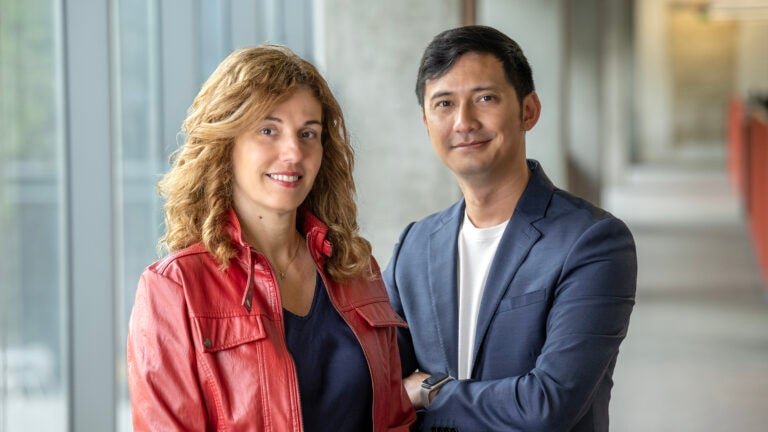Vaia Lida Chatzi (left) and Max Aung are studying the health impacts of PFAS, a group of manmade chemicals linked to fatty liver disease, fertility issues, learning delays, hypertension, cancer and other ailments. They recently received an $8 million, 5-year grant from the National Institute of Environmental Health Sciences to establish a USC Superfund center to research and address PFAS contamination. (USC Photo/Gus Ruelas)
Environment
Battling forever chemicals in the environment: Vaia Lida Chatzi and Max Aung
Chatzi and Aung’s work evolved from treating patients to preventing disease entirely.
USC Trojan Family Magazine is featuring Trojans who have made a significant difference in sustainability at the University of Southern California.
USC scientist Vaia Lida Chatzi, born in Greece, had always wanted to be a doctor — but once she became one, she realized she couldn’t change the world by treating individual patients. What she wanted to do was prevent disease entirely. So, she began a PhD in occupational health, studying asthma among agricultural workers.
“That’s where it all began,” says Chatzi, a professor of population and public health sciences at the Keck School of Medicine of USC. “I realized how heavily exposed these workers were to pesticides, often without any protective equipment. And yes, we found their exposure was causing their asthma.”
Today, Chatzi and fellow USC researcher Max Aung are studying the health impacts of PFAS, a group of manmade chemicals linked to fatty liver disease, fertility issues, learning delays, hypertension, cancer and other ailments.
It’s an urgent problem: PFAS are everywhere, used in everything from fast-food wrappers and waterproof clothing to nonstick cooking pans. Known as “forever chemicals,” they don’t break down quickly and tend to accumulate in drinking water, soil and in our bodies. Nearly all Americans have PFAS in their blood.
Finding forever chemicals in water
In 2023, Chatzi and Aung were awarded the President’s Sustainability Initiative Award by USC Research and Innovation to study PFAS in drinking water in Southern California. That same year, Aung appeared at a news conference with California Attorney General Rob Bonta, announcing enforcement of a new California law requiring manufacturers to restrict PFAS in food packaging and enact labeling requirements for cookware.
They recently published research linking PFAS to sleep disturbances. Another study found that PFAS in drinking water are related to the incidence of certain digestive, endocrine, respiratory, and mouth and throat cancers.
Now, with an $8 million, 5-year grant from the National Institute of Environmental Health Sciences — one of the National Institutes of Health — Chatzi will lead a new USC Superfund center to research and address PFAS contamination. Scientists from the USC Viterbi School of Engineering will explore ways to remove PFAS from polluted water, including through the use of special microbes, chemicals or heating methods that can break down the chemicals.
“Lida and Max are transforming how we understand and confront environmental health risks,” says Ishwar Puri, senior vice president of research and innovation at USC. “Their research on PFAS — from uncovering health impacts to advancing policy and remediation — exemplifies science in service of prevention of disease and lasting public impact.”
A personal journey to studying public health
Like Chatzi, Aung — who joined USC in 2022 — began thinking about human health at a young age. He wasn’t familiar with environmental health as a scientific discipline but grew up knowing his hometown of Bakersfield had the most polluted air in the nation.
“Everyone knows it’s one of the most polluted areas in the country, but it’s not easy to move away, so people just adapt to living with these conditions,” says Aung, an assistant professor of environmental health at the Keck School of Medicine.
While majoring in molecular biology in college, Aung also researched in a paleoceanography lab, collecting sediment samples from the ocean floor. He helped analyze those samples to reconstruct past climate conditions. He says his two areas of study — molecular biology and environmental science — felt disconnected.
“But then I discovered the field of environmental health, and that’s where everything clicked,” Aung says. “It was the perfect way to merge my scientific training with my personal experiences.”
Chatzi, who has studied PFAS for 15 years, sensed a kindred spirit when Aung interviewed at USC.
“I was on the search committee,” Chatzi says. “Max gave a fantastic seminar — very thoughtful, with a strong commitment to environmental health. We clicked right away.” Their collaboration started with PFAS and omics biomarker research. (Omics is a new term for the study of all the molecular components of a biological system, including genes, proteins, RNA, and metabolites, such as genomes and microbiomes).
“His strengths in data science and community engagement complement my background in environmental epidemiology and public health,” she adds. “It’s been a natural and energizing partnership.”
For his part, Aung says that as he considered his next move, he carefully considered potential colleagues like Chatzi at each institution. He concluded that USC felt like a place where he could thrive.
Chatzi concurs: “One reason I’ve stayed at USC is its vibrant research community and commitment to public health. It’s a place where translational research isn’t just a buzzword — we’re doing science with real-world impact.”



